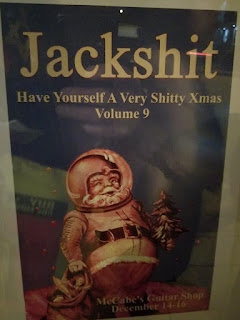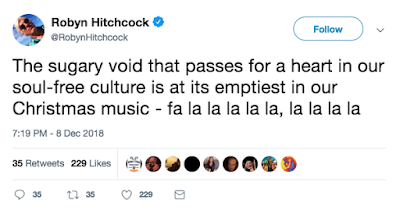Less Is More: The Waterboys — Where The Action Is
Album review by Eric Sandberg
Mike Scott used to make music so big that the first three albums by his band The Waterboys are collectively referred to as "The Big Music." The fiery young Irishman wrote passionate, powerful songs about important things and delivered them, with key band mates multi-instrumentalist Karl Wallinger and saxophonist Anthony Thistlethwaite, in a manner that is required listening.
Wallinger, a gifted songwriter himself, departed to form World Party, after which The Waterboys broke through with "The Whole of the Moon" from their third album This Is the Sea. After this success Scott decamped from London back to Ireland with a huge batch of new songs that veered away from rock toward folk. The addition of fiddle/mandolin player Steve Wickham enhanced the charm of these songs and Fisherman's Blues is regarded by many as the band's high watermark.
After a fine follow up, Room To Roam, their final album of new material for Chrysalis Records, Scott signed a deal with Geffen, moved to New York City, put together a whole new Waterboys and made some not so big music. After the relative failure of Dream Harder Scott made two low key albums under his own name before resurrecting the Waterboys moniker permanently, ably restoring the name's reputation with two strong albums A Rock In the Weary Land and Universal Hall which boast appearances from both Thistlethwaite and Wickham.
Scott continues to deliver a steady stream of Waterboys product including unreleased material from the Fisherman's Blues sessions, live albums and several albums of new songs backed mostly by session musicians. Lately, perhaps aware of his own mortality, Scott has ramped up the band's activity releasing three new albums in five years including the double album Out of All This Blue in 2017.
Though this must be heaven for a Waterboys "Mike can do know wrong" acolyte, it has been a bit of a strain on the discerning completest that is this writer. On Fisherman's Blues Scott wrote a song called "And a Bang On the Ear" an ode to to girlfriends past which, though lovely, established Scott as a bit of a rake. In the late era of The Waterboys many of Scott's songs fall into two categories:
1) name-dropping famous people and,
2) past girlfriends
Late, iconic musicians pervade Scott's dreams. The Beatles, Jimi Hendrix and Elvis have all appeared to him and gotten a song out of it. Out of All this Blue is a twenty-three song litany of women he has loved and left, or have wised up and left him. This, coupled with Scott's new fascination with already tired hip-hop beats, renders the entire affair a bit ponderous.
Only two years later, Scott and The Waterboys have released yet another album of all-new material Where the Action Is. Oy vey! But wait...from the opening power chords of the driving title track, this album sounds like it might be fun. Tasty organ fills — check, wickedly distorted fiddle from Steve Wickham — check, some really decent songs that aren't all about girlfriends — check.
Track two "London Mick" is the inevitable name-dropping song but, this time, The Clash's Mick Jones isn't appearing in a dream — apparently they saw This Is Spinal Tap in a theater together. Track three is the title track from the previous album Out of All this Blue which has some very nice Matthew Fisher style organ from Paul Brown.
Tracks four and five present a pair of songs that are among the best Scott has written in years. "Right Side of Heartbreak (Wrong Side of Love)" is inescapably catchy while "In My Time on Earth" finds Scott looking back on his passionate youth and recapturing quite a bit of it.
"Ladbroke Grove Symphony" continues his reminiscing but "Take Me There I Will Follow You" is drenched in faux hip-hop with a programmed drum loop, rap backing vocals and [ulp!] scratchin'. "And There's Love" is another old girlfriend song which comes off as sincere but is again steeped in a hip hop vibe that just doesn't suit the song. "Then She Made the Lasses O" is also marred by loops and beats but is ultimately rescued by Steve Wickham's delightful fiddle.
The album closes with "Piper At the Gates of Dawn" a compelling recitation of a passage from The Wind In the Willows by Kenneth Graham over a beautiful piano melody reminiscent of mid period Rick Wright and Wickham's ethereal electrified fiddle.
Taken all in, Where the Action Is represents a tentative return to form and further verification of the old adage less is more.
https://www.mikescottwaterboys.com/
Mike Scott used to make music so big that the first three albums by his band The Waterboys are collectively referred to as "The Big Music." The fiery young Irishman wrote passionate, powerful songs about important things and delivered them, with key band mates multi-instrumentalist Karl Wallinger and saxophonist Anthony Thistlethwaite, in a manner that is required listening.
Wallinger, a gifted songwriter himself, departed to form World Party, after which The Waterboys broke through with "The Whole of the Moon" from their third album This Is the Sea. After this success Scott decamped from London back to Ireland with a huge batch of new songs that veered away from rock toward folk. The addition of fiddle/mandolin player Steve Wickham enhanced the charm of these songs and Fisherman's Blues is regarded by many as the band's high watermark.
After a fine follow up, Room To Roam, their final album of new material for Chrysalis Records, Scott signed a deal with Geffen, moved to New York City, put together a whole new Waterboys and made some not so big music. After the relative failure of Dream Harder Scott made two low key albums under his own name before resurrecting the Waterboys moniker permanently, ably restoring the name's reputation with two strong albums A Rock In the Weary Land and Universal Hall which boast appearances from both Thistlethwaite and Wickham.
Scott continues to deliver a steady stream of Waterboys product including unreleased material from the Fisherman's Blues sessions, live albums and several albums of new songs backed mostly by session musicians. Lately, perhaps aware of his own mortality, Scott has ramped up the band's activity releasing three new albums in five years including the double album Out of All This Blue in 2017.
Though this must be heaven for a Waterboys "Mike can do know wrong" acolyte, it has been a bit of a strain on the discerning completest that is this writer. On Fisherman's Blues Scott wrote a song called "And a Bang On the Ear" an ode to to girlfriends past which, though lovely, established Scott as a bit of a rake. In the late era of The Waterboys many of Scott's songs fall into two categories:
1) name-dropping famous people and,
2) past girlfriends
Late, iconic musicians pervade Scott's dreams. The Beatles, Jimi Hendrix and Elvis have all appeared to him and gotten a song out of it. Out of All this Blue is a twenty-three song litany of women he has loved and left, or have wised up and left him. This, coupled with Scott's new fascination with already tired hip-hop beats, renders the entire affair a bit ponderous.
Only two years later, Scott and The Waterboys have released yet another album of all-new material Where the Action Is. Oy vey! But wait...from the opening power chords of the driving title track, this album sounds like it might be fun. Tasty organ fills — check, wickedly distorted fiddle from Steve Wickham — check, some really decent songs that aren't all about girlfriends — check.
Track two "London Mick" is the inevitable name-dropping song but, this time, The Clash's Mick Jones isn't appearing in a dream — apparently they saw This Is Spinal Tap in a theater together. Track three is the title track from the previous album Out of All this Blue which has some very nice Matthew Fisher style organ from Paul Brown.
Tracks four and five present a pair of songs that are among the best Scott has written in years. "Right Side of Heartbreak (Wrong Side of Love)" is inescapably catchy while "In My Time on Earth" finds Scott looking back on his passionate youth and recapturing quite a bit of it.
"Ladbroke Grove Symphony" continues his reminiscing but "Take Me There I Will Follow You" is drenched in faux hip-hop with a programmed drum loop, rap backing vocals and [ulp!] scratchin'. "And There's Love" is another old girlfriend song which comes off as sincere but is again steeped in a hip hop vibe that just doesn't suit the song. "Then She Made the Lasses O" is also marred by loops and beats but is ultimately rescued by Steve Wickham's delightful fiddle.
The album closes with "Piper At the Gates of Dawn" a compelling recitation of a passage from The Wind In the Willows by Kenneth Graham over a beautiful piano melody reminiscent of mid period Rick Wright and Wickham's ethereal electrified fiddle.
Taken all in, Where the Action Is represents a tentative return to form and further verification of the old adage less is more.
https://www.mikescottwaterboys.com/






Comments
Post a Comment